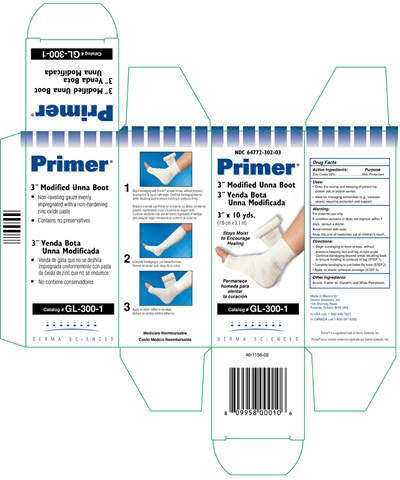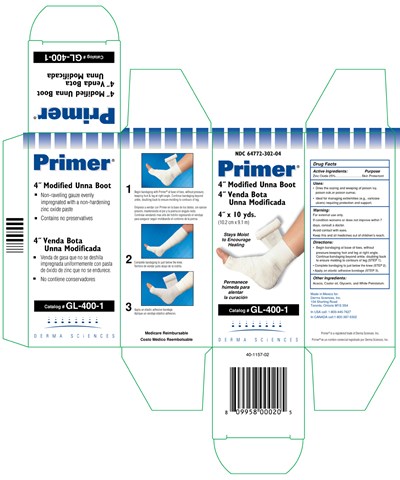Product Images Primer
View Photos of Packaging, Labels & Appearance
Product Label Images
The following 2 images provide visual information about the product associated with Primer NDC 64772-302 by Derma Sciences Canada, Inc., such as packaging, labeling, and the appearance of the drug itself. This resource could be helpful for medical professionals, pharmacists, and patients seeking to verify medication information and ensure they have the correct product.
Label 3" Modified Unna boot Label - GL3001 Primer

This appears to be a mix of text from different sources including medical jargon, pharmaceutical information, and manufacturer details. It mentions a "Modified Unna Boot" which is a non-raveling gauze impregnated with a non-hardening zinc oxide paste that contains no preservatives - it is also said to encourage healing. The drug facts section notes active ingredients and usage information, as well as a warning to consult a doctor if the condition does not improve within 7 days. The address and contact information for Derma Sciences is included, as well as a "Catalog" and "NDC" number. It is not possible to provide a more precise description given the nature of the text.*
Label 4" Modified Unna boot Label - GL4001 Primer

This is a product description for a medical bandage called Modified Unna Boot, made by Derma Sciences. The bandage is impregnated with a non-hardening zinc oxide paste and contains no preservatives, making it suitable for managing external wounds such as poison ivy, poison oak, or wounds that require protection and support. It stays moist for a longer time, which can help promote healing. The bandage comes in a non-raveling gauze and is applied by beginning bandaging at the base of the wound and continuing beyond the ankle, and can be used with an elastic adhesive bandage. The bandage is Medicare reimbursable, has a 25% zinc oxide concentration, and comes in a 47 x 10 yards size. The drug presentation also contains warnings and a list of ingredients.*
* The product label images have been analyzed using a combination of traditional computing and machine learning techniques. It should be noted that the descriptions provided may not be entirely accurate as they are experimental in nature. Use the information in this page at your own discretion and risk.